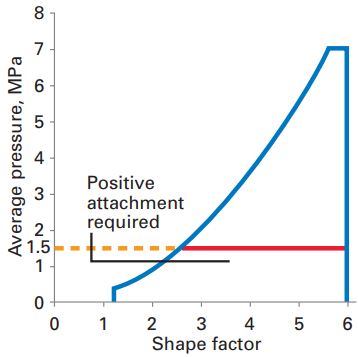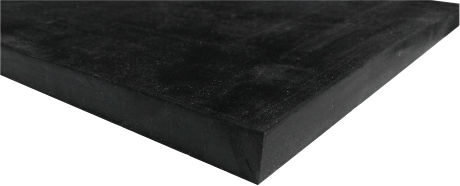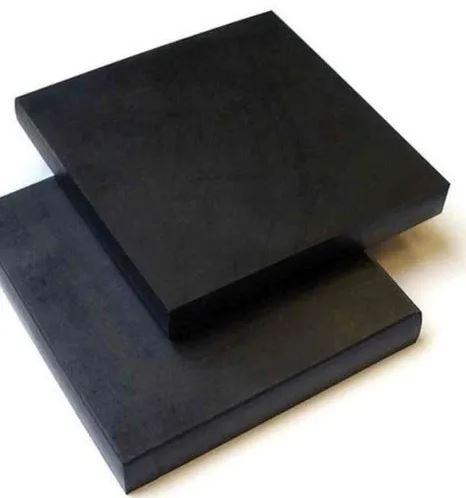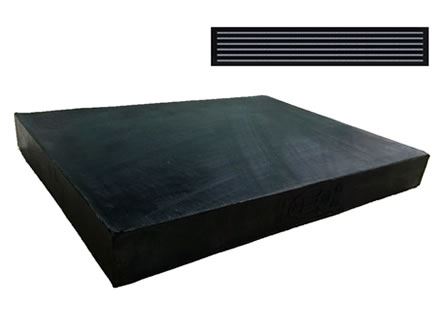Benchmark Stocks plain and shimmed bearings are available in standard Shore A durometers of 50, 60 or 70 based on state and/or AASHTO Code, Section 18, natural rubber or neoprene. For economy, a commercial grade is also available.
PTFE-surfaced neoprene-backed slide bearings are also available. Type CSA material is recommended bonded to a 10-gauge steel laminate which has been bonded to neoprene.
If minimum dead load pressure is less than 200 psi, it is recommended that the elastomer be epoxy-bonded to concrete. If being welded on steel, an 8 gauge tack plate is recommended for positive reinforcement and ease of application. The maximum temperature at a neoprene bearing is 200° F.
Neoprene Synthetic Elastomeric Bearing Pads can be used for bridges, viaducts, buildings, storage tanks, sealing elements, isolation, etc.
Neoprene Synthetic Elastomeric Bearing Pads are made of an elastomer containing neoprene (polychloroprene) as the base polymer. Neoprene Synthetic Elastomeric Bearing Pads are available primarily in 55 durometer hardness (Shore A) and meet the CAN/CSA-S6-06 standard, or in hardness meeting Ontario OPSS 1202. Neoprene Synthetic Elastomeric Bearing Pads are available in roll form, sheet form or cut to specific bearing pad sizes with or without holes or slots.
Laminated Steel Elastomer Bearing Pads are now in service in tens of thousands of bridges and similar structures throughout the world.
Laminated elastomeric bearing pad, one type of reinforced elastomeric bearings, is made of multi-layer rubber and reinforced with steel plate through sulfuration and adhesion. Compared with non-reinforced elastomeric bearing, it has sufficient vertical rigidity which can reliably transfer the concentrated down-loads and impact loads of the superstructure to both ends of the pier. What's more, laminated elastomeric bearing pad not only has fine elasticity which can adapt the rotation of beam end but also has great shearing deformation capacity which can satisfy the horizontal displacement of the superstructure. Thus, it is often applied for steel bridge, PC bridge, RC bridge including right, curved, or skew angled bridge.
AASHTO Grade Plain Bearing Pads
Benchmark offers high quality Neoprene (polychloroprene) and natural rubber (polyisoprene) elastomeric bearing pad material to meet AASHTO and many other specifications.
Plain elastomeric bearing pads are used for a variety of purposes in the bridge and construction industries. They allow for expansion and contraction of precast and steel components. The amount of movement depends on the thickness of the bearing pad. Elastomeric bearings are also used to minimize the effects of vibration on the structure and to dissipate noise. Benchmark has stock in Canada of elastomeric bearing pad material to meet the specifications of all 50 states and Canada.
Benchmark stocks both Natural Rubber Elastomeric Pads and Synthetic Rubber Elastomeric Pads
We stock from 1/8" thick to 1" thick and can supply up to 30" thick as a custom order.
Benchmark stocks elastomeric bearing pads in up to 60" widths in both roll and sheet form. We have the inhouse capacity to cut our raw elastomeric bearing pad material to virtually and shape and can also cut holes or slots.
Specifications Met:
- AASHTO M250-06, grade 3 (Neoprene)
- AASHTO M251-06, grade 5 (Natural Rubber)
- AREMA
- Caltrans
- ASTM D4014 Bearing Pads
- CAN/CSA Natural Rubber Elastomeric Bearing Pads

Elastomeric Bearing Pad Properties (standard)
Durometer
Hardness, Shore A
Tensile Strength, Min PSI
Elongation, % Min
Compression % Max 22 Hrs @ 212 F
Temperature Range
Neoprene Bearing Pads
60
55-65
2250
350
35
Neoprene Bearing Pads
70
65-75
2250
300
35
Natural Rubber Bearing Pads
60
55-65
2250
350
-40 to +200 F
Natural Rubber Bearing Pads
70
65-75
2250
300
-40 to +200 F
Benchmark accepts no responsibility for individual results obtained. Everyone is strongly recommended to verify data and obtain their own independent test results. This data is subject to change without notice.




